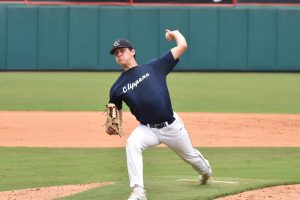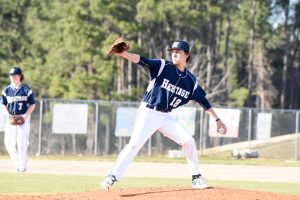Brian Schiff’s Blog
Injury Prevention, Sports Rehab & Performance Training Expert
High school baseball season is upon us. My son is a high school junior and recently verbally committed to pitch for a Division 1 school. He has worked hard to earn that offer, but the part most people do not see is the arm care and recovery work we do for him behind the scenes. Below is a recent picture of him in action.

I see lots of baseball players in my clinic ranging from 10 year olds to my MLB guys. One of the biggest issues I confront in my players (more commonly pitchers and catchers) is a condition known as internal impingement. While not the same thing as subacromial impingement, it still can impact the rotator cuff. Essentially, there is friction that causes irritation and in some cases injury to the rotator cuff and/or labrum. This usually manifests as pain in late cocking and the inability to throw hard without pain. Pitchers report decreased velocity and catchers struggle to thrown down to second with their their normal ease.
One of the most common issues leading to this is a loss of total shoulder motion on the throwing arm. Most notably, some players display significantly less internal rotation (IR) range of motion. Some loss of internal rotation is normal and expected over time provided they gain enough external rotation (ER) on the throwing side to counterbalance the asymmetry. Often, too much throwing early in the season or a big jump in pitch count/intensity/volume coupled with the ROM loss causes pain. This can occur suddenly or gradually build up over a few outings or games.
I came across some very good reads on Twitter last week week that I wanted to pass along. The first is a blog post by Rich Willy, a PT, professor and researcher who specializes in running and running related injuries. If you or any of your friends have suffered from nagging IT Band pain, this is a must read. In this post, he discusses proper treatment strategies:
The second pearl involves long toss and force on the elbow. Ever wonder how advising a pitcher to reduce his throwing intensity actually impacts velocity and torque on the elbow? It seems that decreasing effort level by 25% and 50% does not equate to the same reduction in actual velocity with a study using the motus sleeve. Read more below:
Baseball Pitchers’ Long Toss Perceived Effort & Actual Velocity
Finally, there has been much discussion about return to sport assessment after ACL reconstruction. Lately, many have begun to question how effective hop testing really is when it cones to determining readiness to return to sport. I use several assessments (one of which is hop testing), but I also feel psychological readiness is crucial.
This article sheds light on the connection between proper single limb landing mechanics and psychological readiness.
Association of Psychological Readiness for RTS after ACLR and Hip and Knee Landing Mechanics
If you follow my blog, then you already know I have a 16 y/o left-handed son who pitches. As a sophomore, he is in the early stages of recruiting and has been to 3-4 showcase camps. He has good size at 6’3″ tall and 184 pounds. He has been up to 82 mph.

We have been told he projects at the D1 level, but he just needs to throw a little harder. Baseball is all about bigger, faster and stronger these days. Analytics and numbers rule the day. Coaches have told us that once he consistently throws 85 plus, the offers will start to roll in.
So, the big push for many pitchers today is gaining velo. There are lots of programs and “experts” on the subject offering online programs, weighted balls, velocity training tools, throwing programs, etc. The two questions I always have are:
- What is safe for throwing athletes?
- What is effective?
As a physical therapist, I only want to pursue things that satisfy both questions above. Personally, I do not believe there is a quick fix, or any one program that will deliver the goods.
I just returned from the Sports Physical Therapy Section’s annual conference in Las Vegas. There were plenty of great presentations from various industry leaders. I thought I would take a moment and summarize a few key points from the conference that may be helpful to clinicians and consumers alike.
The conference theme was the power of innovation. Hot topics covered were blood flow restriction therapy, cupping, dry needling, eccentric loading for tendiopathy, weighted ball training, and kinesiotaping and laser therapy to name a few. Below are some takeaways worth mentioning:
- Blood flow restriction (BFR) training can be used to help reduce muscle atrophy after surgery, improve muscle protein synthesis and provide a way to increase strength with loads as low as 20-30% of 1RM for clients unable to tolerate heavy loading
- BFR is not superior to nor a substitute for high intensity training (need to push weight to see best strength gains), but it can be used as an adjunct to training. It also produces an increase in IGHF1 after exercise.
- BFR should not be used before higher intensity activities such as HIT, plyometrics, SAQ, etc.
- Clinicians and strength coaches should consider Olympic lifting derivatives as an alternative to traditional lifts if there is concern with catch phases or biomehcanical/physical concerns. Examples include high pulls/snatch pulls instead of traditional cleans and snatches.
Continue reading…
In my previous post, I outlined the history and findings related to my son’s medial elbow pain. Since publication of that blog post, I have since been given the results of his MR arthrogram and have further updates. If you did not read the prior post, you can click here to read it.
Initially, my concern was tendinitis or more of a flexor/pronator strain given his mild yet persistent soreness and response to rest. The imaging revealed that his UCL was pristine, the radiocapitellar joint liked good, no osteophyte formation or really any inflammation in the soft tissue. The surge told me he had to look closely, but there was evidence of mild fluid around the apophysis. So, in essence, there was some overload/strain being placed on the growth plate.
Given that my son’s growth plates are still open at age 15, he was experiencing some overload (apophysitis) rather than strain on the UCL itself. Had he been skeletally mature, there likely would have been more stress being placed directly on the ligament itself. So, this was good news for all of us.
We received the results on Tuesday October 31. With clearance to pitch last weekend as tolerated by the MD, I elected to have my son throw a bullpen last week. He threw 25 pitches on Wednesday night (one week ago) and was at 100% and pain free. As such, I let him throw 40 pitches in our showcase game last Saturday. He again threw pain free. Now that Fall baseball has ended, we will shut him down for some extended rest and focus on arm care and overall strength and conditioning as he continues his HS workouts.
Some key takeaway points for players, parents and coaches:
- Never dismiss pain that occurs with throwing
- Educate players about throwing related soreness/tightness (such as lactic acid build up that would be typical after a start on the mound) so they can differentiate that from true pain
- If velocity, mechanics or performance in a player suddenly drops, be suspicious of a potential injury knowing that most players will try to throw through it (look for shaking/rubbing of the arm, grimacing or other body language that is outside the player’s normal routine)
- If you suspect an injury, seek out an immediate assessment from a knowledgeable physical therapist and/or MD who treats baseball players as they will do a more comprehensive evaluation and uncover the root cause of dysfunction faster
- Getting imaging in a higher level player will provide peace of mind for the athlete, parent and coach allowing for proper care and progression back to pitching as evidenced in this situation
- Managing pitch counts, innings pitched and recovery between appearances will be instrumental in preventing or reducing injuries
In the end, we must rely on the athletes to communicate what they re feeling. Often, pitcher push through fatigue and pain in the spirit of competition. It is imperative that we advise against this in order to promote long term health and prevent more serious injuries. I know I feel fortunate that my son’s injury was not serious at all.
Moving forward, I will adjust his off season and in-season throwing to ensure he actually conditions his arm with more frequent throwing (not pitching) to ensure his endurance is better, as I feel this may have been a factor in his overuse scenario. While he threw a weekly bullpen this summer, he only threw on average 2 days per week on top of that. He threw daily in middle school ball last year and never had any arm related issues on the mound.
Each player is different in terms of their build, pitching capacity, arm talent, etc. With that said, I think it is important to analyze their performance over the year based on innings pitched, pitch counts, rest between outings, strength program, throwing programs and perceived fatigue to evaluate what works bets for the player. Educating players and parents about arm care and health management strategies will reduce injuries and facilitate long term success for pitchers that have a chance to play in college and beyond.

